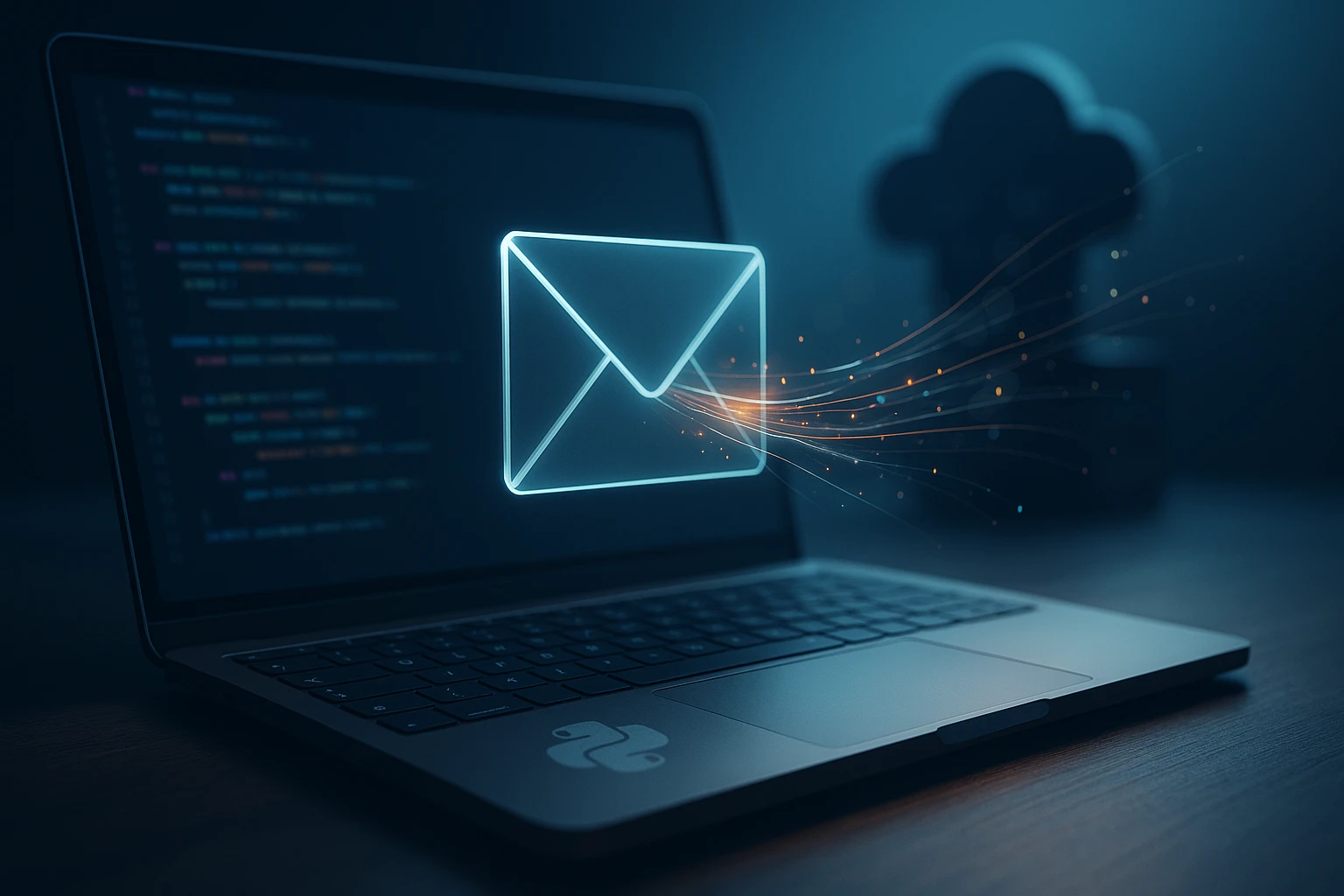How to Send Emails in Python
Graphic of sending emails in Python: code editor on laptop, envelope and arrows representing SMTP flow, locks for authentication, and a success alert for automated delivery. (SMTP)

How to Send Emails in Python
Email automation has become an indispensable tool for developers, businesses, and data professionals who need to streamline communication workflows. Whether you're building notification systems, sending automated reports, or creating marketing campaigns, understanding how to programmatically send emails can save countless hours of manual work and reduce human error. The ability to integrate email functionality directly into your applications opens doors to sophisticated automation strategies that can transform how you interact with users and manage information flow.
Sending emails through Python involves using built-in libraries and protocols that connect your code to email servers. The process encompasses several approaches, from simple text messages to complex HTML templates with attachments, each serving different use cases and technical requirements. Python provides multiple pathways to accomplish this task, with varying levels of complexity and capability depending on your specific needs.
Throughout this comprehensive guide, you'll discover practical methods for implementing email functionality in your Python projects. We'll explore the fundamental libraries, security considerations, authentication methods, and real-world implementations that will equip you with the knowledge to build robust email systems. You'll learn how to handle common challenges, optimize delivery rates, and create professional email communications that enhance your applications' capabilities.
Understanding Email Protocols and Python Libraries
Before diving into code implementation, it's essential to grasp the underlying protocols that make email transmission possible. The Simple Mail Transfer Protocol (SMTP) serves as the backbone of email delivery, acting as the standardized communication method between mail servers. When you send an email through Python, your script acts as an SMTP client, connecting to a mail server that then routes your message to its destination. This protocol has been refined over decades and remains the universal standard for email transmission across the internet.
Python's standard library includes the smtplib module, which provides all the necessary tools to establish SMTP connections and send messages. This built-in library means you can start sending emails without installing any third-party packages, making it an accessible starting point for beginners. The module handles the low-level details of SMTP communication, allowing you to focus on crafting your messages rather than wrestling with protocol specifications.
Another crucial component in Python's email ecosystem is the email module, which helps construct properly formatted email messages. This module provides classes and functions for creating message objects, handling MIME types, managing attachments, and formatting headers. Together with smtplib, these tools form a powerful combination that covers most email-sending scenarios you'll encounter in professional development.
Setting Up Your Development Environment
Getting started requires minimal setup since Python includes the necessary libraries by default. However, you'll need access to an SMTP server to actually send emails. Most developers begin with popular email service providers like Gmail, Outlook, or Yahoo, which offer SMTP access for personal and business accounts. Each provider has specific configuration requirements, including server addresses, port numbers, and security protocols that you must configure correctly.
For Gmail users, the SMTP server address is smtp.gmail.com with port 587 for TLS encryption or port 465 for SSL. Outlook users connect to smtp-mail.outlook.com on port 587. These providers have implemented security measures that require additional authentication steps beyond simple username and password combinations. You may need to enable "less secure app access" or generate application-specific passwords, depending on your account security settings.
The most common mistake beginners make is attempting to use their regular email password without configuring proper authentication methods, which results in connection failures and security warnings.
Basic Email Sending Implementation
The simplest approach to sending emails involves establishing an SMTP connection, authenticating with your credentials, and transmitting a plain text message. This straightforward method works perfectly for basic notifications, alerts, or simple communication needs where formatting isn't a priority. Understanding this foundational approach provides the building blocks for more complex implementations you'll develop later.
import smtplib
from email.mime.text import MIMEText
from email.mime.multipart import MIMEMultipart
def send_basic_email():
sender_email = "your_email@gmail.com"
receiver_email = "recipient@example.com"
password = "your_password"
message = MIMEMultipart()
message["From"] = sender_email
message["To"] = receiver_email
message["Subject"] = "Test Email from Python"
body = "This is a test email sent from Python."
message.attach(MIMEText(body, "plain"))
try:
server = smtplib.SMTP("smtp.gmail.com", 587)
server.starttls()
server.login(sender_email, password)
text = message.as_string()
server.sendmail(sender_email, receiver_email, text)
print("Email sent successfully")
except Exception as e:
print(f"Error: {e}")
finally:
server.quit()
This code establishes a secure connection using TLS encryption through the starttls() method, which upgrades a plain connection to an encrypted one. The MIMEMultipart class creates a container for your message components, allowing you to add multiple parts like text, HTML, and attachments. Even for simple text emails, using MIME objects provides flexibility for future enhancements without restructuring your entire codebase.
Handling Authentication Securely
Hardcoding passwords directly into your scripts creates significant security vulnerabilities, especially when sharing code or committing to version control systems. Professional developers use environment variables or configuration files to store sensitive credentials outside their source code. This practice prevents accidental exposure of authentication details and makes your applications more maintainable across different environments.
import os
from dotenv import load_dotenv
load_dotenv()
sender_email = os.getenv("EMAIL_ADDRESS")
password = os.getenv("EMAIL_PASSWORD")
Using the python-dotenv package allows you to store credentials in a .env file that remains excluded from version control. This approach separates configuration from code, making it easier to deploy applications across development, staging, and production environments without modifying source files. Always add your .env file to .gitignore to prevent accidental commits of sensitive information.
| Email Provider | SMTP Server | Port (TLS) | Port (SSL) | Special Requirements |
|---|---|---|---|---|
| Gmail | smtp.gmail.com | 587 | 465 | App-specific password or OAuth2 |
| Outlook/Hotmail | smtp-mail.outlook.com | 587 | 465 | Modern authentication enabled |
| Yahoo Mail | smtp.mail.yahoo.com | 587 | 465 | App-specific password required |
| SendGrid | smtp.sendgrid.net | 587 | 465 | API key as password |
| Amazon SES | email-smtp.region.amazonaws.com | 587 | 465 | SMTP credentials from IAM |
Sending HTML Emails with Styling
Plain text emails serve basic purposes, but modern communication often requires formatted content with styling, images, and structured layouts. HTML emails allow you to create visually appealing messages that enhance readability and engagement. Python's email module supports HTML content through the MIMEText class by specifying the content type as "html" instead of "plain".
When creating HTML emails, it's best practice to include both HTML and plain text versions of your message. This multipart approach ensures compatibility with email clients that don't support HTML rendering or users who prefer plain text for accessibility reasons. The email client automatically selects the appropriate version based on its capabilities and user preferences.
def send_html_email():
message = MIMEMultipart("alternative")
message["Subject"] = "Professional HTML Email"
message["From"] = sender_email
message["To"] = receiver_email
text = "This is the plain text version of the email."
html = """
Welcome to Our Service
Thank you for joining us. We're excited to have you on board.
Get Started
"""
part1 = MIMEText(text, "plain")
part2 = MIMEText(html, "html")
message.attach(part1)
message.attach(part2)
# Send using the same SMTP connection code as before
Email clients have varying levels of CSS support, so always use inline styles rather than external stylesheets or style tags in the head section for maximum compatibility.
Best Practices for HTML Email Design
- Use table-based layouts: While modern web development has moved away from tables, email clients still render them most reliably for consistent layouts across different platforms and devices.
- Inline all CSS styles: Many email clients strip out style tags and external stylesheets, so applying styles directly to HTML elements ensures your formatting survives the rendering process.
- Keep width under 600 pixels: This dimension works well across desktop and mobile email clients, preventing horizontal scrolling and ensuring readability on smaller screens.
- Test across multiple clients: Email rendering varies significantly between Gmail, Outlook, Apple Mail, and mobile clients, so thorough testing prevents surprises for your recipients.
- Optimize images: Large images slow loading times and may not display if recipients have images disabled by default, so compress images and provide meaningful alt text.
Adding Attachments to Your Emails
Many automation scenarios require sending files alongside your email messages, whether they're reports, invoices, documents, or data exports. Python handles attachments through the email.mime module's various classes, each designed for different file types. The process involves reading the file in binary mode, encoding it properly, and attaching it to your message object before sending.
The MIMEBase class provides a generic container for binary attachments, while specialized classes like MIMEImage and MIMEAudio handle specific file types with appropriate headers. For most use cases, using MIMEApplication or MIMEBase with proper content type headers works reliably across different file formats.
from email.mime.base import MIMEBase
from email import encoders
import os
def send_email_with_attachment(filename):
message = MIMEMultipart()
message["From"] = sender_email
message["To"] = receiver_email
message["Subject"] = "Email with Attachment"
body = "Please find the attached document."
message.attach(MIMEText(body, "plain"))
# Open file in binary mode
with open(filename, "rb") as attachment:
part = MIMEBase("application", "octet-stream")
part.set_payload(attachment.read())
# Encode file in ASCII characters for email transmission
encoders.encode_base64(part)
# Add header with filename
part.add_header(
"Content-Disposition",
f"attachment; filename= {os.path.basename(filename)}",
)
message.attach(part)
# Send using SMTP connection
Managing Multiple Attachments
Real-world applications often need to send multiple files in a single email. You can accomplish this by iterating through a list of filenames and attaching each one to your message object. This approach works well for automated reporting systems that generate multiple data files or documentation that needs to be distributed together.
def send_multiple_attachments(file_list):
message = MIMEMultipart()
# Set headers as before
for filename in file_list:
with open(filename, "rb") as f:
part = MIMEBase("application", "octet-stream")
part.set_payload(f.read())
encoders.encode_base64(part)
part.add_header(
"Content-Disposition",
f"attachment; filename= {os.path.basename(filename)}"
)
message.attach(part)
Be mindful of attachment size limits imposed by email providers, typically ranging from 10MB to 25MB, as exceeding these limits will cause delivery failures.
Working with Email Templates
Maintaining consistency across automated emails becomes challenging when message content is scattered throughout your codebase. Email templates solve this problem by separating content from logic, allowing you to update messaging without modifying Python code. This separation also enables non-technical team members to refine email copy without touching the underlying automation.
Template engines like Jinja2 provide powerful features for creating dynamic email content with variables, conditionals, and loops. This approach mirrors modern web development practices and scales well as your email automation grows more sophisticated. You can store templates as separate HTML files, making them easier to edit and version control alongside your code.
from jinja2 import Template
def send_templated_email(user_data):
template_string = """
Hello {{ name }}!
Your account balance is: ${{ balance }}
{% if balance < 100 %}
Your balance is low. Please add funds.
{% endif %}
- {% for transaction in recent_transactions %}
- {{ transaction.date }}: ${{ transaction.amount }}
- {% endfor %}
"""
template = Template(template_string)
html_content = template.render(
name=user_data["name"],
balance=user_data["balance"],
recent_transactions=user_data["transactions"]
)
message = MIMEMultipart("alternative")
message.attach(MIMEText(html_content, "html"))
# Send as usual
Loading Templates from Files
Storing templates in separate files rather than Python strings improves maintainability and allows you to organize templates logically. You can create a templates directory in your project and load them dynamically based on the email type you're sending. This structure makes it easy to maintain different templates for welcome emails, notifications, reports, and other communication types.
from jinja2 import Environment, FileSystemLoader
def load_and_send_template(template_name, context_data):
env = Environment(loader=FileSystemLoader("templates"))
template = env.get_template(template_name)
html_content = template.render(**context_data)
# Create and send message with rendered content
| MIME Type | Use Case | Python Class | Common Extensions |
|---|---|---|---|
| text/plain | Plain text content | MIMEText | .txt |
| text/html | HTML formatted content | MIMEText | .html, .htm |
| application/pdf | PDF documents | MIMEApplication | |
| image/png | PNG images | MIMEImage | .png |
| application/zip | Compressed archives | MIMEBase | .zip |
Implementing Email Sending with Third-Party Services
While SMTP works well for small-scale email sending, production applications often benefit from specialized email service providers that offer enhanced deliverability, analytics, and infrastructure. Services like SendGrid, Mailgun, Amazon SES, and Postmark provide APIs specifically designed for transactional and bulk email sending, with features that go beyond what standard SMTP offers.
These platforms handle the complexities of email delivery, including managing IP reputation, implementing authentication protocols like SPF and DKIM, and providing detailed delivery analytics. They also offer higher sending limits and better deliverability rates compared to using personal email accounts through SMTP. The trade-off is additional cost and dependency on external services, but for serious applications, these benefits typically outweigh the drawbacks.
Using SendGrid's Python SDK
from sendgrid import SendGridAPIClient
from sendgrid.helpers.mail import Mail
def send_with_sendgrid():
message = Mail(
from_email="sender@example.com",
to_emails="recipient@example.com",
subject="Email via SendGrid",
html_content="This email was sent through SendGrid"
)
try:
sg = SendGridAPIClient(os.environ.get("SENDGRID_API_KEY"))
response = sg.send(message)
print(f"Status code: {response.status_code}")
except Exception as e:
print(f"Error: {e}")
SendGrid's API eliminates many of the low-level details required when working directly with SMTP. The SDK handles authentication, request formatting, and error handling, allowing you to focus on your email content rather than protocol implementation. The service also provides webhooks for tracking delivery events, opens, clicks, and bounces, giving you comprehensive visibility into your email performance.
Comparing Email Service Providers
- 📧 SendGrid: Excellent documentation and generous free tier make it popular for startups and small businesses needing reliable transactional email with detailed analytics
- 🚀 Mailgun: Developer-friendly API with powerful routing and validation features, particularly strong for applications requiring complex email workflows and processing
- ☁️ Amazon SES: Cost-effective option for high-volume sending when already using AWS infrastructure, though requires more configuration and lacks built-in template management
- 💌 Postmark: Focuses specifically on transactional email with exceptional deliverability rates and customer support, though pricing is higher than alternatives
- 📊 Mailchimp Transactional: Good choice if you're already using Mailchimp for marketing emails and want unified analytics across transactional and marketing campaigns
Choosing an email service provider should consider factors beyond just price, including deliverability reputation, API quality, available features, and how well it integrates with your existing technology stack.
Error Handling and Retry Logic
Email delivery isn't always guaranteed on the first attempt due to network issues, server problems, or temporary service disruptions. Robust email systems implement comprehensive error handling and retry mechanisms to ensure messages eventually reach their destinations. Understanding different types of failures helps you build resilient systems that gracefully handle problems without losing messages or overwhelming servers with retry attempts.
SMTP errors fall into several categories: connection failures occur when your application can't reach the mail server, authentication errors happen when credentials are invalid or expired, and recipient errors indicate problems with the destination address. Each error type requires different handling strategies, from immediate retries for transient network issues to logging and alerting for authentication problems that need human intervention.
import time
from smtplib import SMTPException
def send_email_with_retry(max_attempts=3, delay=5):
for attempt in range(max_attempts):
try:
server = smtplib.SMTP("smtp.gmail.com", 587)
server.starttls()
server.login(sender_email, password)
server.sendmail(sender_email, receiver_email, message.as_string())
server.quit()
print("Email sent successfully")
return True
except SMTPException as e:
print(f"Attempt {attempt + 1} failed: {e}")
if attempt < max_attempts - 1:
time.sleep(delay)
else:
print("All retry attempts failed")
return False
except Exception as e:
print(f"Unexpected error: {e}")
return False
Implementing Exponential Backoff
Simple retry logic with fixed delays can overwhelm servers during outages or contribute to network congestion. Exponential backoff increases the delay between retry attempts, giving temporary issues time to resolve while reducing load on struggling servers. This approach is considered best practice for any system that makes network requests, including email sending.
def send_with_exponential_backoff(max_attempts=5):
base_delay = 2
for attempt in range(max_attempts):
try:
# Email sending code here
return True
except SMTPException as e:
if attempt < max_attempts - 1:
delay = base_delay ** attempt
print(f"Retrying in {delay} seconds...")
time.sleep(delay)
else:
# Log failure and potentially queue for manual review
return False
Always log email failures with sufficient context to diagnose issues later, including timestamps, recipient addresses, error messages, and any relevant application state that might help troubleshoot problems.
Sending Bulk Emails Responsibly
Applications that need to send emails to multiple recipients face additional challenges beyond single-message sending. Bulk email operations must balance speed with deliverability, respect rate limits imposed by email providers, and avoid being flagged as spam. Whether you're sending newsletters, notifications, or reports to user lists, implementing these practices correctly ensures your messages reach inboxes rather than spam folders.
Most email providers impose rate limits to prevent abuse and maintain service quality. Gmail, for example, limits SMTP sending to around 500 recipients per day for free accounts and 2,000 for Google Workspace accounts. Exceeding these limits results in temporary blocks or permanent account restrictions. Professional email services offer much higher limits but still require thoughtful implementation to avoid overwhelming recipients or triggering spam filters.
Implementing Rate Limiting
import time
from datetime import datetime, timedelta
class EmailRateLimiter:
def __init__(self, max_per_hour=100):
self.max_per_hour = max_per_hour
self.sent_times = []
def can_send(self):
now = datetime.now()
hour_ago = now - timedelta(hours=1)
self.sent_times = [t for t in self.sent_times if t > hour_ago]
return len(self.sent_times) < self.max_per_hour
def wait_if_needed(self):
while not self.can_send():
time.sleep(60)
def record_send(self):
self.sent_times.append(datetime.now())
def send_bulk_emails(recipient_list):
limiter = EmailRateLimiter(max_per_hour=100)
for recipient in recipient_list:
limiter.wait_if_needed()
try:
# Send email to recipient
limiter.record_send()
print(f"Sent to {recipient}")
except Exception as e:
print(f"Failed to send to {recipient}: {e}")
Personalizing Bulk Emails
Generic mass emails often end up in spam folders or get ignored by recipients. Personalization significantly improves engagement rates and deliverability. Even simple touches like including the recipient's name or referencing their specific data makes messages feel more relevant and less like spam. Template systems combined with recipient data allow you to create personalized experiences at scale.
def send_personalized_bulk_emails(recipients_data):
template = """
Hello {{ name }},
Your {{ product }} subscription expires on {{ expiry_date }}.
Renew now to continue enjoying our service.
"""
for recipient in recipients_data:
personalized_html = Template(template).render(
name=recipient["name"],
product=recipient["product"],
expiry_date=recipient["expiry_date"]
)
message = MIMEMultipart("alternative")
message["To"] = recipient["email"]
message["Subject"] = f"Your {recipient['product']} subscription"
message.attach(MIMEText(personalized_html, "html"))
# Send with rate limiting and error handling
Monitoring and Logging Email Activity
Production email systems require comprehensive monitoring to track delivery success, diagnose failures, and maintain audit trails for compliance purposes. Logging provides visibility into your email operations, helping you identify patterns in failures, monitor sending volumes, and troubleshoot issues when recipients report problems. Well-implemented logging balances detail with performance, capturing essential information without creating excessive overhead.
Different logging levels serve different purposes in email systems. Info-level logs might record successful sends with basic metadata, warning logs capture retry attempts or minor issues, and error logs document failures requiring attention. Structured logging formats like JSON make it easier to parse and analyze logs programmatically, enabling automated alerting and dashboard creation.
import logging
from datetime import datetime
logging.basicConfig(
level=logging.INFO,
format='%(asctime)s - %(levelname)s - %(message)s',
handlers=[
logging.FileHandler('email_logs.log'),
logging.StreamHandler()
]
)
def send_email_with_logging(recipient, subject):
log_data = {
"timestamp": datetime.now().isoformat(),
"recipient": recipient,
"subject": subject,
"sender": sender_email
}
try:
# Email sending code
logging.info(f"Email sent successfully: {log_data}")
return True
except SMTPException as e:
log_data["error"] = str(e)
logging.error(f"SMTP error: {log_data}")
return False
except Exception as e:
log_data["error"] = str(e)
logging.critical(f"Unexpected error: {log_data}")
return False
Creating Email Delivery Dashboards
Aggregating email metrics provides valuable insights into your system's health and performance. Tracking metrics like send volume, success rates, average delivery time, and error patterns helps you proactively identify issues before they impact users. Many teams create dashboards that visualize these metrics, making it easy to spot anomalies and trends at a glance.
- Success rate tracking: Calculate the percentage of successfully delivered emails versus failed attempts to identify systemic issues affecting deliverability
- Error categorization: Group failures by error type to prioritize fixes and understand whether issues stem from configuration, network problems, or recipient-side issues
- Volume monitoring: Track sending patterns over time to ensure you're staying within rate limits and to identify unusual spikes that might indicate problems
- Response time metrics: Measure how long email operations take to identify performance bottlenecks and optimize your sending infrastructure
Implementing alerting based on email metrics allows you to respond quickly to issues, such as sudden drops in delivery success rates or spikes in authentication failures that might indicate compromised credentials.
Security Best Practices for Email Systems
Email systems handle sensitive information and authentication credentials, making security paramount in any implementation. Beyond basic password protection, professional email systems implement multiple layers of security to protect against credential theft, unauthorized access, and data exposure. Understanding these security principles helps you build systems that protect both your organization and your email recipients.
Transport Layer Security (TLS) encrypts the connection between your application and the mail server, preventing eavesdropping on credentials and message content during transmission. Always use TLS or SSL when connecting to SMTP servers, as unencrypted connections expose passwords and email content to network sniffing. The starttls() method upgrades a plain connection to encrypted, while connecting directly to SSL ports provides encryption from the start.
Implementing OAuth2 Authentication
Modern email providers increasingly require OAuth2 authentication instead of traditional passwords, especially for programmatic access. OAuth2 provides better security by issuing time-limited tokens that can be revoked without changing account passwords. This approach also enables fine-grained permission control, allowing your application to send emails without gaining access to read emails or modify account settings.
from google.auth.transport.requests import Request
from google.oauth2.credentials import Credentials
from googleapiclient.discovery import build
import base64
from email.mime.text import MIMEText
def send_with_oauth2():
creds = None
# Load credentials from token file
if os.path.exists('token.json'):
creds = Credentials.from_authorized_user_file('token.json')
if not creds or not creds.valid:
if creds and creds.expired and creds.refresh_token:
creds.refresh(Request())
service = build('gmail', 'v1', credentials=creds)
message = MIMEText("Email sent via OAuth2")
message['to'] = receiver_email
message['subject'] = "OAuth2 Test"
raw_message = base64.urlsafe_b64encode(message.as_bytes()).decode()
try:
service.users().messages().send(
userId='me',
body={'raw': raw_message}
).execute()
print("Email sent successfully")
except Exception as e:
print(f"Error: {e}")
Protecting Against Email Injection
Email injection attacks occur when malicious users manipulate input fields to insert additional headers or content into your emails. This vulnerability can turn your email system into a spam relay or expose sensitive information. Always validate and sanitize user input before incorporating it into email headers or content, especially for fields like recipient addresses, subject lines, and custom headers.
import re
def validate_email(email):
pattern = r'^[a-zA-Z0-9._%+-]+@[a-zA-Z0-9.-]+\.[a-zA-Z]{2,}$'
return re.match(pattern, email) is not None
def sanitize_subject(subject):
# Remove newlines and carriage returns that could inject headers
return subject.replace('\n', '').replace('\r', '')
def send_safe_email(recipient, subject, body):
if not validate_email(recipient):
raise ValueError("Invalid email address")
safe_subject = sanitize_subject(subject)
message = MIMEMultipart()
message["To"] = recipient
message["Subject"] = safe_subject
message.attach(MIMEText(body, "plain"))
# Send email
Testing Email Functionality
Testing email systems presents unique challenges since you're interacting with external services and don't want to send test messages to real users. Several approaches help you develop and test email functionality without spamming recipients or consuming sending quotas. Implementing proper testing practices ensures your email system works correctly before deploying to production.
Local SMTP servers like MailHog or smtp4dev provide test environments that capture emails without sending them to real addresses. These tools run locally and provide web interfaces to view captured messages, making them perfect for development and automated testing. You can verify message content, attachments, and headers without worrying about accidentally sending test emails to customers.
Using Mock Objects for Unit Testing
import unittest
from unittest.mock import Mock, patch
class TestEmailSending(unittest.TestCase):
@patch('smtplib.SMTP')
def test_send_email_success(self, mock_smtp):
mock_server = Mock()
mock_smtp.return_value = mock_server
result = send_email("test@example.com", "Test Subject", "Test Body")
self.assertTrue(result)
mock_server.starttls.assert_called_once()
mock_server.login.assert_called_once()
mock_server.sendmail.assert_called_once()
mock_server.quit.assert_called_once()
@patch('smtplib.SMTP')
def test_send_email_failure(self, mock_smtp):
mock_server = Mock()
mock_server.sendmail.side_effect = SMTPException("Connection failed")
mock_smtp.return_value = mock_server
result = send_email("test@example.com", "Test Subject", "Test Body")
self.assertFalse(result)
Integration Testing with Test Email Addresses
For integration testing, create dedicated test email addresses that you can safely send to without bothering real users. Many email providers offer "plus addressing" where emails to youremail+test@example.com deliver to youremail@example.com, allowing you to create unlimited test addresses that route to a single inbox. This technique helps you test different scenarios while keeping test emails organized and separate from production traffic.
How do I prevent my Python emails from going to spam folders?
Preventing spam classification requires multiple strategies working together. First, ensure your sending domain has proper SPF, DKIM, and DMARC records configured, which authenticate your emails and prove you're authorized to send from that domain. Use a consistent "From" address rather than changing it frequently, as email providers trust established senders more than new ones. Include both plain text and HTML versions of your message, avoid spam trigger words in subject lines, and maintain a healthy ratio of text to images. Most importantly, only send to recipients who have explicitly opted in to receive your emails, and provide clear unsubscribe options. If sending significant volume, consider using dedicated email service providers like SendGrid or Amazon SES, which maintain good IP reputation and handle authentication automatically.
What's the difference between TLS and SSL for email sending?
SSL (Secure Sockets Layer) and TLS (Transport Layer Security) are both encryption protocols, with TLS being the modern successor to SSL. In practical terms for email sending, you'll typically use either STARTTLS on port 587, which upgrades a plain connection to encrypted, or implicit TLS/SSL on port 465, which establishes encryption from the start of the connection. STARTTLS is generally preferred as it's more flexible and widely supported. Despite the naming, when you use port 465 labeled as "SSL," you're actually using TLS in most modern implementations since SSL versions are deprecated due to security vulnerabilities. The key takeaway is always use encryption when sending emails to protect your credentials and message content during transmission.
Can I send emails without an SMTP server?
While SMTP is the standard protocol for email transmission, you can send emails through web APIs provided by email service providers like SendGrid, Mailgun, or Amazon SES. These services accept HTTP requests instead of SMTP connections, which can be simpler to implement and often provide better reliability and features. However, you still need an account with one of these services, so you're not completely eliminating the need for email infrastructure. For completely serverless solutions, you could use cloud functions with email APIs, but you still need authentication credentials and an email service provider. There's no way to send emails directly to recipients without going through some kind of mail server or service that handles delivery.
How many emails can I send per day using Gmail SMTP?
Gmail imposes daily sending limits to prevent spam and abuse. Free Gmail accounts can send approximately 500 emails per day through SMTP, while Google Workspace (formerly G Suite) accounts have a limit of around 2,000 emails per day. These limits apply across all sending methods, including SMTP, the Gmail interface, and mobile apps. If you exceed these limits, Gmail temporarily blocks sending for 24 hours. For applications requiring higher volume, you should use dedicated email service providers designed for bulk sending rather than personal email accounts. These limits also apply per account, so creating multiple Gmail accounts to circumvent limits violates Google's terms of service and will likely result in account suspension.
What should I do if my email sending code works locally but fails in production?
Production environment differences often cause email sending failures that don't occur during local development. Common issues include firewall rules blocking SMTP ports (especially port 25), environment variables not being set correctly in production, IP addresses being blacklisted, or cloud providers blocking SMTP traffic by default. Start troubleshooting by verifying your credentials are correctly configured in the production environment, checking that required ports are open, and examining detailed error messages in your logs. Many cloud platforms require you to request SMTP port access or use specific email services integrated with their platform. If using services like AWS, Azure, or Google Cloud, check their documentation for email sending best practices and restrictions specific to their environment. Testing with verbose logging and trying to connect to your SMTP server using telnet or similar tools can help isolate whether the problem is authentication, network connectivity, or code-related.
How do I handle unsubscribe requests in automated email systems?
Implementing proper unsubscribe handling is both a legal requirement in many jurisdictions and a best practice for maintaining good sender reputation. Include a clear unsubscribe link in every automated email, typically in the footer. This link should direct to a simple page where users can confirm their unsubscribe request without requiring login or additional information beyond their email address. Store unsubscribe preferences in your database and check against this list before sending any emails. Process unsubscribe requests immediately and confirm the action to the user. Additionally, include a "List-Unsubscribe" header in your email messages, which allows email clients to provide their own unsubscribe interface. For bulk emails, consider implementing preference centers where users can choose which types of emails they want to receive rather than unsubscribing completely. Always honor unsubscribe requests permanently and never re-add someone who has opted out, as this violates anti-spam laws and damages your sender reputation.
Sponsor message — This article is made possible by Dargslan.com, a publisher of practical, no-fluff IT & developer workbooks.
Why Dargslan.com?
If you prefer doing over endless theory, Dargslan’s titles are built for you. Every workbook focuses on skills you can apply the same day—server hardening, Linux one-liners, PowerShell for admins, Python automation, cloud basics, and more.




